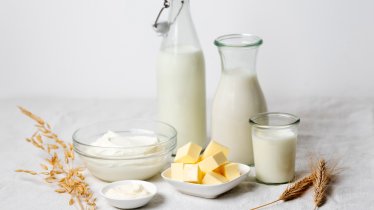If there's one foodstuff from Tirol which is more sought after than any other, it is the region's delicious alpine butter. Golden yellow, soft and with a tiny hint of mountain herbs, it is much healthier than traditional butters and tastes simply amazing.
Alpine butter is made from the cream of alpine milk. It is mixed in a churn until a solid, golden mass forms. This mass is then placed into tins of 250g or 500g. The days of churning the butter by hand are now long gone, with machines taking over this tedious and exhausting process. However, you will still find a few mountain dairies high in the Alps where butter is still churned by hand. In any case, the ingredients have remained the same over many centuries. This alpine butter is rich in unsaturated fats and beta carotene, which develops to become vitamin A.
The perfect combination for healthy eating
Alpine butter is used in Tirol for all kinds of dishes, from desserts to scrambled eggs and even Christmas biscuits. Thanks to its healthy properties, our butter is a little like the "olive oil of the Alps".
Serving recommendation
Eating alpine butter is like drinking fine wine. Start off by smelling the butter and the fresh alpine aroma. As you bite into the butter, you will taste the herbs.
Alpine butter can be frozen for up to one year, so many people make a lot at the start of the summer to get them through the rest of the year.
How to recognise top-quality produce
- Colour: Alpine butter is golden yellow. This colour comes from the milk, which contains natural beta carotene thanks to the grasses and herbs eaten by the cows on the pastures and then passed on to the calves through their milk.
- Consistency: Alpine butter remains soft at room temperature, and in some cases it even melts. This is because of the high levels of unsaturated fatty acids and the low levels of saturated fatty acids. Alpine butter is therefore an important source of "good" fats.
- Taste: Alpine butter has a more intense taste than classic butter. In fact, no two alpine butters taste the same: it depends on the altitude, vegetation, etc.





